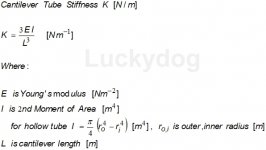A google suggests that MA had some severe QC issues which did them no favours. Shame as we seem to have lost a lot of the good tech and there is no business case to start up with it again.
I believe those cartridges suffered, at this time, of their simiraties with cheap piezzo electric ones of these kind of material:
https://i.ytimg.com/vi/5FZNAIiVWQI/hqdefault.jpg that we used for surprise parties ;-)
https://i.ytimg.com/vi/5FZNAIiVWQI/hqdefault.jpg that we used for surprise parties ;-)
I believe those cartridges suffered, at this time, of their simiraties with cheap piezzo electric ones of these kind of material:
https://i.ytimg.com/vi/5FZNAIiVWQI/hqdefault.jpg that we used for surprise parties ;-)
If you read the link, the engineering at MA was quite sophisticated there are still folks keeping theirs alive and several dealers still have stock of the replacement stylii.
Familiar story...
MA went bankrupt in 1984. The company was totally trashed by Bose in a lawsuit over alleged patent violation. MA had been selling loudspeakers with a distributed tweeter array. Unfortunatly, the court sided with the plainiff's wildly-absurd claim; anyone with rudimentary audio knowledge can see that the two product lines had virtually no similarity.
Last edited:
@ Scott Wurcer
Thank you for explanation.
@SY
I think, .....................
Some of them in need of additional tonarm wires for power supply.
Audio note (Japan) made a cartridge with 6 leads, 2 of which were for power I believe.
Interesting timing but this was posted today Listening #152 | Stereophile.com
Horrifically poor journalism and fact checking (effectively claims soundsmith invented MI and is the only company making them), then I realised; not sure this is any worse than 90% of the tech reporting in hifi mags since about 1980. Not suprising that we have so much misinformation out there!
Horrifically poor journalism and fact checking (effectively claims soundsmith invented MI and is the only company making them), then I realised; not sure this is any worse than 90% of the tech reporting in hifi mags since about 1980. Not suprising that we have so much misinformation out there!
I shall restore normality by reading a reprint of a 1958 review of the decca ffss stereo 'pickup'
Interesting timing but this was posted today Listening #152 | Stereophile.com
Horrifically poor journalism and fact checking (effectively claims soundsmith invented MI and is the only company making them), then I realised; not sure this is any worse than 90% of the tech reporting in hifi mags since about 1980. Not suprising that we have so much misinformation out there!
Hmmm, I saw B&O credited, but in any case we all know the Grado line of MI. This looks like I got a nice tour from passionate folks and I'll make up a nice read to fill a few pages.
That's also weapons-grade poor writing.
One of the buttons for me is a certain tone that removes the author from accountability for getting any technical details right. I ran into this with some friends that wrote for TAS.
EDIT - please take my quote in #71403 with a grain of salt, Ill never learn not to trust web surfers opinions of patent suits. In the only suit I could find MA actually won, but maybe it drained their wallets? The language of the court brief was so obscure one might stand there and ask, "did I win?"
Last edited:
This looks like I got a nice tour from passionate folks and I'll make up a nice read to fill a few pages.
Now gimme a check!
That's also weapons-grade poor writing.
Admit it. You got to "I scarcely missed being involved in an accident" and you stopped reading.
Very little of the exotic cantilever stuff makes sense to me.Yes, but the 30 B has a solid boron rod, no tube. ( some say ist beryllium, but most sources say boron)
Today laser drilling is possible, whatever material, but with alu you can press fit due softness, then adjust the diamond and then glue, minimal amount, boron is very hard (9,3 Mohs), density is nearly like alu, so there i see no advantage for solid boron, its more mass than a tube.
A never ending story 🙂
The challenge is simple: devise a cantilever as stiff as possible using a given mass budget. The aim is to make the cantilever move as a body, rather than flex, and when it moves as a body its mass matters.
See attached equation describing stiffness of a tube or rod cantilever. Stiffness depends on radius to the 4th power, and inversely on length to the third power. Then geometry totally dominates choice of material as to stiffness, at least between Al, B, Be and ruby.
Best answer for how to use the mass budget is to use as fat a hollow tube as possible, with as thin walls as possible, and make the cantilever as short as possible. There is far more action in changing the geometry of an Al cantilever than changing the material to B, Be etc.
Solid rods are a particularly poor use of mass if one works it out..........
So a short fat thin walled Al tube would be far stiffer than any exotic standard geometry cantilever.
Another pretty weird artefact of the vinyl world, exotic material cantilevers then....................?
See the images below for cantilever transverse and tortional stiffness equations, check it out.
Attachments
Last edited:
As an experiment I'm listening right now to something that should just not work. A 5mV sensitivity cartridge directly into a miniDSP with no amplification, digital RIAA and a 20dB line amp into a 20W T-amp. the result is perfectly listenable with all volume controls at 11 (Brendel playing Liszt).
If we have a typical Al tube cantilever, decrease its length and increase its radius by about 25% and adjust wall thickness to conserve mass, it would be as stiff as a B cantilever of the original dimensions yet have the same mass.What about Boron or Be tubes then?
The obvious thing to do to restore the gain is make shorter fatter B tube cantilevers, but we don't see those, if anything they tend to be rods and/or skinnier........we don't even see many short fat Al cantilevers.
Cantilever geometry as to length and cross section profile, rather than material properties, typically dominates stiffness per mass.
Last edited:
I saw that Alfred was giving a lecture in Oxford this morning, I nearly went. Would have but the prom in London this eve was a bit special, all 5 Prokofiev piano concertos in one evening, back to back. Gergiev and the LSO, 3 pianists in rotation -anybody else go to this one, it was more than a bit good ?The result is perfectly listenable with all volume controls at 11 (Brendel playing Liszt).
If we have a typical Al tube cantilever, decrease its length and increase its radius by about 25% and adjust wall thickness to conserve mass, it would be as stiff as a B cantilever of the original dimensions yet have the same mass.
The obvious thing to do to restore the gain is make shorter fatter B tube cantilevers, but we don't see those, if anything they tend to be rods and/or skinnier........we don't even see many short fat Al cantilevers.
Cantilever geometry as to length and cross section profile, rather than material properties, typically dominates stiffness per mass.
Thank you, very interesting reading.
When i spoke with my Cartridgemaker, he explained me very well, that he try to make the best compromise between mass, stiffness and damping properties of his cantilevers, which are hollow alu tubes.
Very short cantilevers tend to limit the trackabilty and giving higher amount of distorsions( or brighter sound with more air 😉 ), both also depending on stylus shape and compliance of the suspension, he sez, most important is the damping rubber properties for MC.
JC - I think i'll go somewhere for awhile... Leave for Asia day after tomorrow for 4 months. Spending the first 3 weeks in Nepal. Got all my shots for that area. Just goofing off, mostly. Visiting my adopted family there and then to Bangkok for R&R at my condo and will do some prototyping and listening and measuring at my old factory. Then sending the Nepal family to island resort for even more R&R. LG.
Enjoy to all.
-Richard Marsh
Enjoy to all.
-Richard Marsh
Last edited:
Of course (And I still have hundreds of great LPs and a strait arm turntable).
Just, I don't see where is the interest to talk so much about-it, to try to design improved preamps for MC cartridges etc...
It is an obsolete technology of the last century which reached its highs in the 70s and which we can not really expect more than it offered in its time.
A beautiful moment technology, which now has no other interest than the pleasures related to "vintage" or 'collection'.
More than this, when some try to make believe that digital is not 'musical' (when I'm not able to make any difference between pre/post good digital recording), this may be a barrier to advances in current technology, which has not reached its peaks and is, yet, thousand times better, even on an economical point of view.


I still have some ADC - CD - DAC tests waiting to do when I get tired of R&R.
-RNM
Last edited:
- Status
- Not open for further replies.
- Home
- Member Areas
- The Lounge
- John Curl's Blowtorch preamplifier part II

